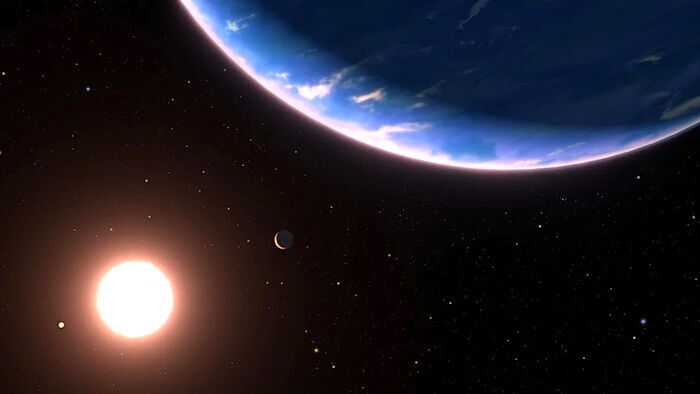
The planet, named GJ 9827d, is about twice Earth's diameter, and it's the smallest exoplanet found to have water vapor in its atmosphere, according to a new study.
Water is essential for life as we know it, but the planet is unlikely to host any type of life due to searing temperatures that would turn a water-rich atmosphere into scorching steam.
The astronomers have yet to uncover the true nature of this unusual world's atmosphere, but the revelation paves the way for further investigation as they seek to understand the origins of planets beyond our solar system.
The findings appeared in a report published Thursday in The Astrophysical Journal Letters.
Study coauthor Laura Kreidberg, managing director of the atmospheric physics of exoplanets department at the Max Planck Institute for Astronomy in Heidelberg, Germany, in a statement said:
"Water on a planet this small is a landmark discovery. It pushes closer than ever to characterizing truly Earth-like worlds."Yet the planet reaches temperatures of 800 degrees Fahrenheit (427 degrees Celsius), making it a steamy, inhospitable world that's as hot as Venus.
Study coauthor Björn Benneke, professor at the University of Montreal's Trottier Institute for Research on Exoplanets, in a statement, said:
"This would be the first time that we can directly show through an atmospheric detection, that these planets with water-rich atmospheres can actually exist around other stars. This is an important step toward determining the prevalence and diversity of atmospheres on rocky planets."Currently, the research team can't tell whether Hubble picked up on water vapor traces within a puffy, hydrogen-rich atmosphere or the planet has a water-rich atmosphere because the host star evaporated GJ 9827d's original hydrogen and helium atmosphere.
Lead study author Pierre-Alexis Roy, a doctoral student at the University of Montreal's Trottier Institute, said:
"Our observing program, led by principal investigator Ian Crossfield of (the University of Kansas) in Lawrence, Kansas, was designed specifically with the goal to not only detect the molecules in the planet's atmosphere, but to actually look specifically for water vapor. Either result would be exciting, whether water vapor is dominant or just a tiny species in a hydrogen-dominant atmosphere."A planetary conundrum
NASA's Kepler mission initially discovered the planet orbiting a red dwarf star in the Pisces constellation in 2017. The exoplanet completes a single orbit around its host star every 6.2 days.
Astronomers observed GJ 9827d during 11 transits, or times when the planet crossed in front of its star during orbit, over three years. Starlight filtering through the planet's atmosphere helped astronomers measure the signature of water molecules.
Benneke said:
"Until now, we had not been able to directly detect the atmosphere of such a small planet. And we're slowly getting in this regime now,. At some point, as we study smaller planets, there must be a transition where there's no more hydrogen on these small worlds, and they have atmospheres more like Venus (which is dominated by carbon dioxide)."Understanding more about the planet's atmosphere could help astronomers classify exactly what type of world GJ 9827d is. Currently, the team has two possible theories.
It's possible that the planet is a mini-Neptune with a hydrogen-rich atmosphere that contains water vapor. If so, GJ 9827d likely formed at a greater distance from the host star than its current location, meaning the planet was colder and water was present in the form of ice (similar to Neptune and Uranus, the most distant planets in our solar system).
As the planet migrated closer to its star and was blasted with more stellar radiation, the hydrogen heated up and escaped, or it's still escaping, according to the researchers.
Or astronomers suspect that GJ 9827d could be a warmer version of Jupiter's icy moon Europa, which contains an ocean beneath a thick, icy crust. The planet might be half water and half rock, Benneke said.
The search for water in space
Water is one of the most common molecules found across the universe, and for years, astronomers have included water detection as a larger part of the search for life beyond Earth.
Study coauthor Thomas Greene, astrophysicist at NASA's Ames Research Center in California's Silicon Valley, in a statement:
"Observing water is a gateway to finding other things. This Hubble discovery opens the door to future study of these types of planets by the James Webb Space Telescope. JWST can see much more with additional infrared observations, including carbon-bearing molecules like carbon monoxide, carbon dioxide, and methane. Once we get a total inventory of a planet's elements, we can compare those to the star it orbits and understand how it was formed."Astronomers have already observed GJ 9827d with the Webb telescope to search for water and other types of molecules, and that data will be shared in the future.
"We can hardly wait to see what those data reveal. Hopefully, we can now settle the question of water worlds once and for all."



the NASA moon buggy left on the moon, apparently, in 1971 is roughly 10ft x 9ft x 4 ft; the distance to the moon is roughly 225600 miles from earth.
has NASA ever provided a photo of the buggy sitting on the moon's surface whether from an orbiting or terrestrial telescope ? But they're trying to find water 97 light years away. Uh Huh.
so kids, discernment means, after you observe / read something you don't immediately make a judgement call - instead you run it through your mental bullshit filter which says either: yeah ok it sounds legit, or no effing way, that reeks to high heaven. And then you make a judgement call.
In this case i call the article a pile of over-ripe bovine enhanced crop sauce.
: )